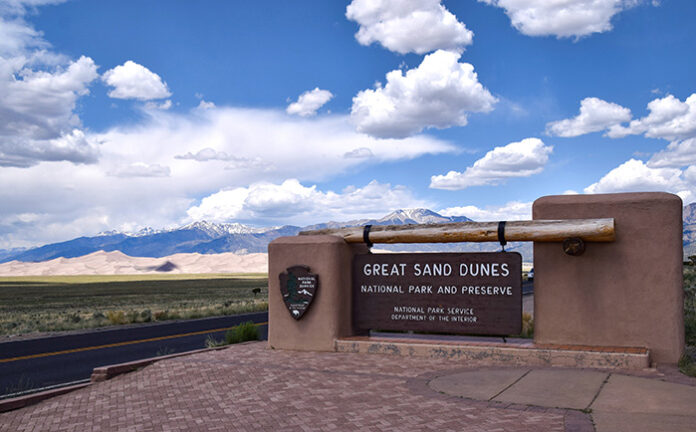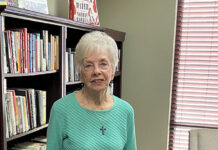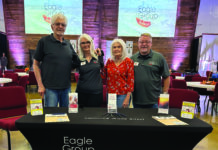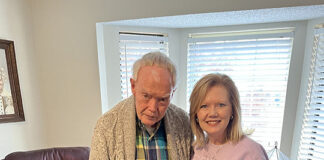By Nick Thomas
If towering mounds of sand have never sparked your curiosity, perhaps a visit to Great Sand Dunes National Park and Preserve might change that. Located a 2-hour drive from Pueblo, Colorado, this stunning landscape was sculpted over the ages by wind and water carrying and depositing sand from nearby mountains. Spanning some 30 square miles, the dunes soar to 750 feet creating the tallest “sand castles” in North America.
Approaching the park along Highway 150 in late spring, we first glimpsed the towering 14,000-foot peaks of the Sangre de Cristo Mountains that dominate the horizon. About 10 miles out, a lighter area at the base of the range began to emerge, gradually taking shape beneath the shadow of the still snow-capped peaks. As we continued along the road, the 1.2 cubic miles of sand became distinct and we couldn’t wait to sink our bare toes into the curious golden grains of earth that seemed so out of place sandwiched between the mountain’s base and valley to the west. Unfortunately, I had foolishly forgotten a well-known interaction between sand and sun!
After a brief stop at the Visitor Center, we had the option of either driving a short distance and parking a few hundred feet from the dunes or trekking across an arid trail behind the Visitor Center – we chose the latter and encountered only one other like-minded couple.
Though bathed in sunshine, the temperature hovered around a mild 80 degrees and the sandy track was a fairly easy 0.5 mile walk to the parking area. Considered a connecting path with no formal trail name, there was a feeling of hiking through a barren wasteland with desert shrubs, dry grasses, and clusters of cactuses stretching off into the distance. With no shade, I expect the heat would be rather intense mid-summer.
As we approached the car park with the sand dunes looming, we were surprised to encounter a water barrier. Medano Creek separated the car park from the dunes and although wide, was quite shallow – just a few inches deep in some spots. Dozens of kids splashed in the broad stream, clearly more captivated by the running water than the surrounding dunes.
After removing our shoes and placing them on the dry sand, we waded across the water. Reaching the other side, I enthusiastically began sprinting up the dunes – well, at least what passes for sprinting at my age. But after about 15 steps I realized something was wrong – the soles and heels of my feet were on fire!
I made a rapid 180, yelping my way back to the cooling water. Although the sun didn’t feel particularly intense, I soon remembered that sand has a low specific heat capacity, meaning it doesn’t take much energy to raise its temperature (unlike other exposed surfaces such as water or grass). It was a lesson not soon forgotten.
Crossing the water once more to collect our shoes, we returned to the dunes and began to ascend the sand mound, this time with shoes securely affixed, but had no aspirations to reach the summit. Trudging through deep, soft sand is exhausting on flat ground – on a steep slope, it’s downright grueling. So after watching in awe those who tackled the punishing peaks attempting to conquer the sandy heights, we hiked back to the Visitor Center and our car.
For several days, my feet felt as though they were afflicted with a mild case of sunburn, but it was a small price to pay to witness this most unusual example of nature’s handiwork.
Nick Thomas teaches at Auburn University at Montgomery in Alabama and has written features, columns, and interviews for many newspapers and magazines. His hiking column describes short trails, hikes, and walks from around the country that seniors might enjoy while traveling. See www.ItsAWonderfulHike.com.
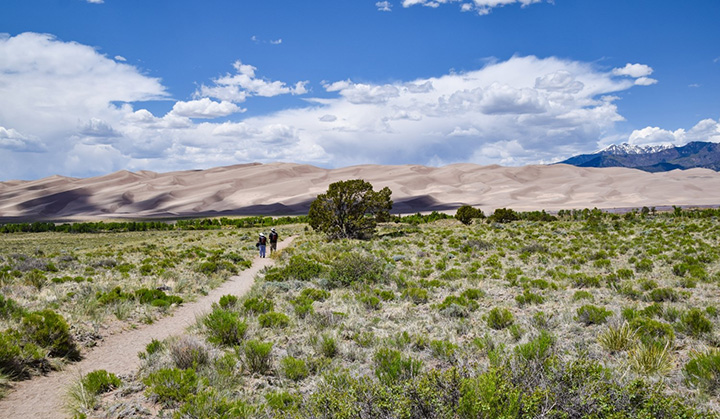
Nick Thomas teaches at Auburn University at Montgomery in Alabama and has written features, columns, and interviews for many newspapers and magazines. His book, “Raised by the Stars: Interviews with 29 Children of Hollywood Actors,” featured a lengthy interview with June Lockhart talking about her father.
See www.getnickt.org.


